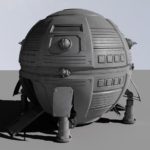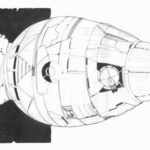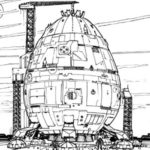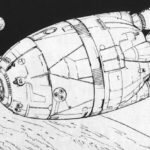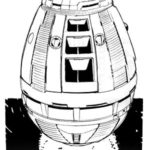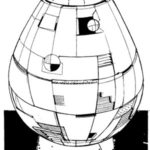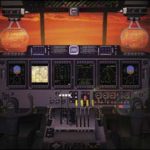These are the often egg-shaped cargo-spaceships designed to make quick trips to and from planet-side.
–
Table of Contents:
- Introduction
- Description
- Sizes
- Types
- Sub-types
- Classification of DropShips
- Images
- History with Auz
–
Introduction:
The purpose of the conceptual dropship is: to expedite landfall, foothold, and fortress construction. Each dropship is a mobile, aerospace-capable, forward operating base (FOB), and rarely has Warp capabilities. Essentially, they take troops, supplies, and a few vehicles from orbit to surface, and back again; they are giant APCs, not intended for combat or long Space flights. They are more like a giant armored Space Shuttle that doesn’t need a launch platform or runway
–
Description:
Dropships are large, often ellipsoid / spheroid, and usually building- to skyscraper-sized unit-mobilizing and staging-area vessels. Dropships are not to be confused with airborne armored personnel carriers (APC), like the Halo saga’s Pelican, or the Alien(s) saga’s UD-4L Cheyenne (which are VTOL-crafts based on fusions of the CH-46 Sea Knight, CH-47 Chinook, and V-22 Osprey). Though these much smaller craft are sometimes colloquially referred to as dropships, they are the tiniest and most primitive version, and only barely technically in the same category as their larger counterparts.
–
Sizes
Giant:
- Dimensional Brackets: town sized
- Example: Behemoth (100,000 tons, with bays for 20 smaller Dropships; carries 74,972 tons of cargo)
- Height: ~275m (90-story building)
- Width / Diameter: ~200m (~1/10 of a mile wide)
- Depth / ‘Length’: ~200m
Large:
- Dimensional Brackets: city-block sized
- Example: Mammoth (52,000 tons, carrying 40,000 tons of cargo, and the largest Dropship capable of planetary operations; going from orbit to surface and back)
- Height: ~170m (56-story building)
- Width / Diameter: ~277m (~1/8 of a mile wide)
- Depth / ‘Length’: ~277m
Medium:
- Dimensional Brackets: skyscraper sized
- Example: Colossus (20,000 tons; moves an entire combined-arms regiment (36 ‘Mechs, 72 vehicles, 12 platoons), * and this is the one the Inisfreean Dropship is modeled after)
- Height: ~165m (54-story building)
- Width / Diameter: ~135m (2.75 football fields wide)
- Depth / ‘Length’: ~125m
Small:
- Dimensional Brackets: office-building sized
- Example: Hercules (7,200 tons, carries 36 heavy vehicles and 12 platoons)
- Height: ~120m (39-story building)
- Width / Diameter: ~84m (1.7 football fields wide)
- Depth / ‘Length’: ~87m
Tiny:
- Dimensional Brackets: house sized
- Example: K-1 Drop Shuttle (200 tons; carries 6 passengers and 16.5 tons of cargo)
- Height: ~28m (9-story building)
- Width / Diameter: ~28m (>1/2 a football field wide)
- Depth / ‘Length’: ~28m
* Even tinier are the ODST Drop-pods, but those are car-sized (too small to be ships, and well below the 200-ton threshold prerequisite for dropship classification), and are only intended as one-way one-man ‘re-entry’ vehicles.
–
Types
A Dropship is any spaceship massing between 200 and 100,000 tons that is itself incapable of faster-than-light (FTL) travel. They essentially conduct all other aspects of space travel, including transit between planets and Jump Points and planetary landings (hence their name). For FTL interstellar movement, they dock with JumpShips by means of a Docking collar.
The mass range is given in the construction rules and reflects the fact that it is more or less impossible to build DropShips which are smaller than 200 tons or larger than 100,000 tons. Since DropShips are meant to be carried by JumpShips, a Docking collar is an implied necessity and is automatically included in the structure of any DropShip.
DropShips are the workhorse of interplanetary space travel. It is the DropShips (and occasionally their smaller cousins, the Small Craft) that move cargo and passengers between planetary surfaces, orbits, space stations and jump points. While transport is their primary role, some have been built for special purposes and act as tugs, rescue ships, fighter carriers or even designated combat DropShips. Accordingly, a wide and diverse variety of DropShip types exist.
Even though many DropShips serve as military spaceships, naval terms such as “Corvette”, “Destroyer”, “Cruiser” etc. are never applied to them; these are exclusively used for true WarShips, i.e. the huge Combat JumpShips that outclass DropShips by an order of magnitude (typically massing several hundred thousands or even millions of tons).
–
Subtypes:
While DropShips often are very large for their tonnage compared to ground- and water-based combat vehicles, they reserve most of their enormous volumes for cargo. As a result, crew facilities in DropShips are usually cramped inside, featuring relatively little in the way of creature-comforts or extra space. Every possible hole or space in a DropShip has some sort of system or mechanism important to the operation and maintenance of the vessel. Most crews live in small, spartan quarters bunking four crewman or more a piece, though Star League-era DropShips, as well as some newer ones as of the late 3060s, feature comparatively spacious twin cabins. Except for passenger liners, which afford their attendants a bit more privacy, DropShips are very public places. Most military DropShips described talk of stale air and overly-cramped living conditions.
They are based around two basic hullforms, aerodyne, and spheroid (egg-shaped). Depending on their intended role, DropShips can be constructed following either of these two alternative approaches.
- Spheroid DropShips: Spheroid (egg-shaped) DropShips use sheer thrust to vertically descend onto a planetary surface and take off in the same way. This allows them to operate independent from runways or even spaceports, making them ideal for exploring unknown planets and giving them a tactical advantage in military operations. However, their simple and versatile landing and taking off pattern comes at a great risk as there is no failsafe whatsoever. They are utterly dependent on the functionality of their powerful engines to generate lift, and a control computer to manage their unstable flight. These systems require more maintenance than on aerodyne ships, and their failure means a swift and deadly crash landing that leaves few if any survivors or salvageable parts.
- Aerodyne DropShips: Any DropShip that is not a spheroid design is considered “aerodyne” even if it is in fact incapable of atmospheric operations. Truly aerodyne DropShips are shaped roughly similar to conventional aircraft. They are generally smaller than spheroid DropShips and cannot be bigger than 35,000 tons (the biggest known aerodyne class being the 17,400-ton Conquistador). Through their speed, they generate lift within an atmosphere which makes them easier to control. Even if the ship suffers damage or loses thrust it is often still possible to facilitate an emergency landing so that crew and cargo might survive. Aerodyne DropShips usually require runways to land and take off, making them impractical wherever runways are not readily available. Some, however, such as the Leopard, can operate from very short and/or makeshift runways, making them almost as versatile as their spheroid cousins.
- Deep Space DropShips: Although all DropShips are either of the spheroid or the aerodyne subtype, there is arguably a third subtype: Ships which are limited to operating in deep space for one reason or another and would be destroyed when attempting to enter an atmosphere or land on a planet, rendering the differences between aerodyne and spheroid designs irrelevant to them. Examples include the super-large Behemoth class cargo hauler, which is a spheroid design but has insufficient acceleration for planetary operations and was also described as too large and fragile to operate in gravity, and the nominally “aerodyne” (i.e. non-spheroid) Achilles and Vengeance class military DropShips which were never designed for atmospheric operations.
–
Classification of DropShips:
In addition to their type, DropShips have mission profiles that they were originally designed for. They include the following.
- Assault: This primary military DropShip is designed for maximum firepower. Typically used for anti-aerospace fighter and anti-DropShip operations, they can be used ground assault purposes but this is rare. Some models of assault ships which carry anti-WarShip weaponry are referred to as Pocket WarShips. This type of DropShip is also known to carry limited quantities of BattleMechs, Battle Armor, Marines, and aerospace fighters; Usually just enough to provide “point-blank” defense.
- Fighter Carrier or Aerospace Carrier: Designed for carrying/supporting aerospace fighter craft operations. Though other DropShips are referred to as ‘Mech Carrier, Troop Carriers, etc., a ship described as a “carrier” is understood to be a fighter carrier. These ships typically have CV (for Carrier Vessel) appended to their name, as in Leopard CV.
- Cargo Ship: Typically civilian model of ship, used for hauling bulk cargo. Some ships are fitted to transport liquids and are usually referred to as Liquid Carriers.
- ‘Mech Carriers: Military type of DropShip, principally designed to carry BattleMechs into combat. They are generally modestly armed.
- Pocket WarShip: A military DropShip type based on the Assault DropShips. These ships are designed to carry Capital Missiles and sometimes Sub-Capital Weaponry. Most are typically heavily armed with standard BattleMech scale weaponry. Early versions of this ship type were known as Q-Ships. Following the Jihad, with so many nations’ shipyards damaged or destroyed, many factions turned to these as the backbone of their navies.
- Q-Ship: Military conversion of a civilian vessel, typically cargo ships. First introduced by the Star League Defense Forces prior to the Star League Civil War.
- Troop Transport: Typical infantry carrying DropShip, which may have capacities of moving various size vehicles. They are normally modestly armed craft.
- Liner: Civilian DropShip design for passenger service. Normally, these ships are lightly or never armed. Rarely these ships are used as Troop Transport for infantry.
–
–
History with Auz:
Within the first generation of any of those dropships being commissioned, the High King of Inisfree made a clandestine trip out to one of them to ‘christen’ it in the traditional Inisfreean way. He just likes experiencing and enhancing mighty creations like these… like that.
–


